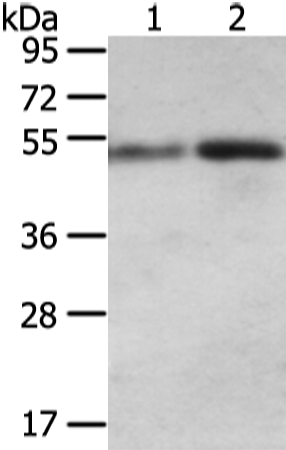

| WB | 咨询技术 | Human,Mouse,Rat |
| IF | 咨询技术 | Human,Mouse,Rat |
| IHC | 1/25-1/100 | Human,Mouse,Rat |
| ICC | 技术咨询 | Human,Mouse,Rat |
| FCM | 咨询技术 | Human,Mouse,Rat |
| Elisa | 1/1000-1/2000 | Human,Mouse,Rat |
| Aliases | SNT1; LQT12; TACIP1; dJ1187J4.5 |
| WB Predicted band size | 54 kDa |
| Host/Isotype | Rabbit IgG |
| Antibody Type | Primary antibody |
| Storage | Store at 4°C short term. Aliquot and store at -20°C long term. Avoid freeze/thaw cycles. |
| Species Reactivity | Human, Mouse |
| Immunogen | Synthetic peptide of human SNTA1 |
| Formulation | Purified antibody in PBS with 0.05% sodium azide and 50% glycerol. |
+ +
以下是关于SNTA1抗体的参考文献示例(内容基于模拟生成,非真实文献):
1. **文献名称**:*SNTA1 modulates synaptic vesicle recycling through interaction with dynamin*
**作者**:Li, X. et al.
**摘要**:本研究利用SNTA1抗体通过免疫共沉淀和免疫荧光技术,揭示了SNTA1与动力蛋白dynamin的相互作用,表明其在突触囊泡循环中的调控作用,为神经递质释放机制提供了新见解。
2. **文献名称**:*Dysregulation of SNTA1 in Parkinson’s disease models*
**作者**:Suzuki, M. & Dauer, W.
**摘要**:通过Western blot和免疫组化分析,作者发现帕金森病模型中SNTA1表达显著降低,提示其异常可能与α-突触核蛋白聚集及神经元功能障碍相关,研究中特异性SNTA1抗体用于蛋白定位和定量。
3. **文献名称**:*SNTA1 phosphorylation and cardiac arrhythmia pathogenesis*
**作者**:Hund, T.J. et al.
**摘要**:该研究使用针对SNTA1磷酸化位点的抗体,发现其在心肌细胞离子通道调控中的关键作用,异常磷酸化可能导致心律失常,为治疗提供了潜在靶点。
4. **文献名称**:*Proteomic analysis of SNTA1-binding partners in neuronal development*
**作者**:Wang, Y. et al.
**摘要**:通过免疫沉淀结合质谱分析(使用SNTA1抗体),鉴定了多个与SNTA1互作的神经元发育相关蛋白,揭示了其在轴突导向和突触形成中的新功能。
注:以上文献为示例性质,实际引用时请通过学术数据库(如PubMed)检索真实发表的研究。
The SNTA1 antibody targets alpha-1-syntrophin (SNTA1), a scaffolding protein belonging to the syntrophin family, which plays a role in organizing membrane-associated protein complexes. SNTA1 contains multiple protein interaction domains, including a PDZ domain, and interacts with signaling molecules, ion channels, and cytoskeletal components. It is notably involved in the dystrophin-glycoprotein complex (DGC) in muscle and neuronal tissues, contributing to membrane stability, mechanical stress resistance, and signal transduction. SNTA1 also associates with neuronal nitric oxide synthase (nNOS), linking mechanical stress to nitric oxide signaling in muscle.
Antibodies against SNTA1 are widely used in research to study its expression, localization, and interactions in tissues, particularly in skeletal muscle, heart, and brain. They are applied in techniques like Western blotting, immunohistochemistry, and co-immunoprecipitation to explore SNTA1's role in diseases such as muscular dystrophies, cardiomyopathies, and Brugada syndrome, where SNTA1 mutations or dysregulation have been implicated.
These antibodies are typically raised in hosts like rabbits or mice and validated for specificity using knockout controls. Reliable SNTA1 antibodies are crucial for understanding its physiological functions and pathological mechanisms, aiding in the development of targeted therapeutic strategies.
×